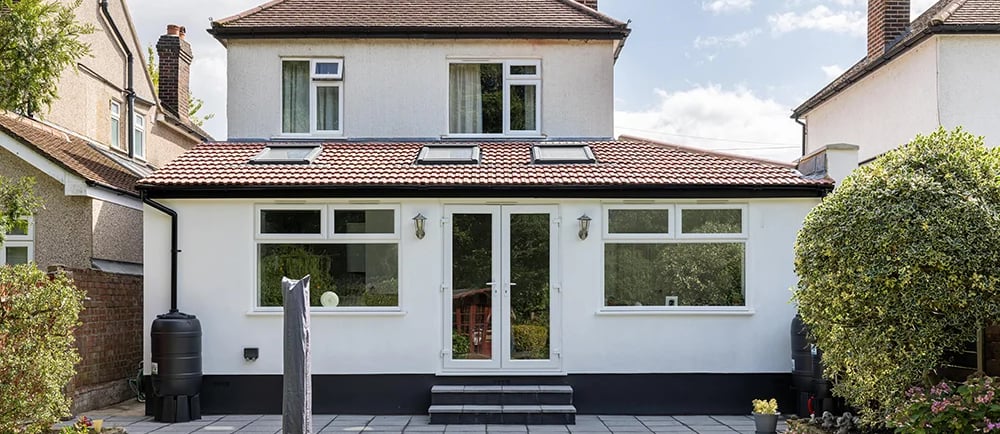Wraparound Extension UK 2025 – Cost, Planning & Best Design Ideas
7/7/20253 min read


Wraparound Extension UK 2025 – Complete Guide to Costs, Ideas & Planning Rules
In 2025, UK homeowners continue to look for clever ways to unlock every inch of living space—and a wraparound extension remains one of the most versatile, valuable ways to do it.
By combining a side return and rear extension, a wraparound turns dark, cramped ground floors into spacious, light-filled kitchens, dining areas, and family zones. Especially for Victorian or Edwardian terraces, it can totally transform how you live at home.
What Is a Wraparound Extension?
A wraparound extension connects a side return extension (filling in the often-wasted alley space beside your house) with a rear extension at the back. Together, they create an L-shaped footprint that wraps around your original house.
This opens up possibilities for a stunning open-plan kitchen-diner, an extra living area, a utility room, or a home office—all flooded with natural light.
Why Choose a Wraparound Extension?
Here’s why a wraparound is so popular for 2025:
✔️ Maximises Space: Fills unused side alleyways and garden space.
✔️ Perfect for Period Homes: Adds modern family living to narrow Victorian or Edwardian terraces.
✔️ Flexible Layouts: Create broken-plan zones, kitchen islands, bi-fold doors, or garden rooms.
✔️ Boosts Property Value: A quality wraparound can add 15–25% to your home’s value in popular UK areas.
✔️ Natural Light: Roof lights and big glass doors brighten dark, narrow layouts.
Best Wraparound Extension Ideas for 2025
Thinking about a wraparound? Here are some trending ideas for UK homes this year:
Open-Plan Kitchen-Diner
Combine your kitchen and dining space into one seamless zone with a big island, statement lighting, and bi-fold doors to the garden.
Broken-Plan Family Hub
Use half walls, Crittall-style doors, or shelving to zone your open space into a kitchen, dining area, and lounge—perfect for busy families.
Hidden Utility & Pantry
A wraparound’s extra floor area is ideal for a tucked-away utility room, laundry zone, or walk-in pantry—keeping clutter out of sight.
Garden Connection
Install huge sliding or bi-fold doors, plus roof lights or a glazed side return to flood the space with light and link indoors to outdoors.
Home Office Nook
Carve out a quiet corner for hybrid working or kids’ homework—cleverly placed behind bespoke storage or shelving.
Statement Materials
Mix traditional London stock brick with modern glazed extensions or zinc-clad roofs for a design that’s sympathetic yet striking.
Planning Permission for Wraparound Extensions in the UK
Do you need planning permission?
Many wraparounds do not fall under Permitted Development (PD) because they extend to the side and rear.
Rules for side extensions are stricter under PD—e.g., they must be single storey, under 4m high, and no wider than half your house.
Rear extensions can be PD if they don’t extend more than 3m (terraced/semi) or 4 m (detached)—but wraparounds usually go beyond this.
So, most wraparound extensions will need a full planning application—especially if you live in a conservation area.
Building Regulations for Wraparounds
Even if you don’t need planning permission, you’ll need Building Control approval for:
Structural calculations: Steel beams to open walls safely.
Thermal performance: Insulation and double/triple glazing.
Drainage: Any new bathrooms or kitchen plumbing.
Fire safety: Escape routes and fire doors if needed.
Foundations: Suitable for the soil and existing structure.
How Much Does a Wraparound Extension Cost in the UK in 2025?
Typical cost guide for a London or UK wraparound:
A typical wraparound might be 20–40m², so expect:
Always add:
Architect & structural engineer fees
Planning application fee (~£250+)
Party Wall Agreement costs if needed
10–15% contingency for surprises
Tips for a Successful Wraparound Extension
Final Thoughts
A wraparound extension remains one of the best investments for UK homes in 2025—especially if you love your neighbourhood but need more space for modern family life
Done well, it’s a chance to add value, transform how you live, and blend old character with fresh, light-filled contemporary design.